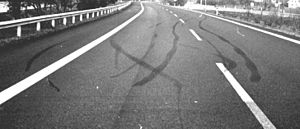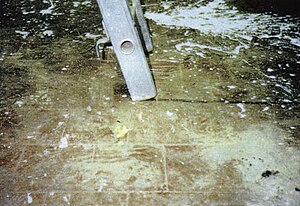Neumann series: Difference between revisions
| Line 1: | Line 1: | ||
{{About||the 2008 film|Skid Marks (film)}} | |||
[[File:Bremsspur.jpg|thumb|Skid marks on an asphalt road.]] | |||
A '''skid mark''' is the visible mark left by any solid which moves against another, and is an important aspect of [[trace evidence]] analysis in [[forensic science]] and [[forensic engineering]]. Skid marks caused by tires on roads occur when a vehicle wheel stops rolling and slides or spins on the surface of the road. Skid marks can be analyzed to find the maximum and minimum vehicle speed prior to an impact or incident. [[Skidding]] can also occur on [[black ice]] or [[Diesel fuel|diesel]] deposits on the road and may not leave a mark at all. | |||
==Characteristics== | |||
[[File:ladder skid mark.jpg|thumb|Skid mark from a faulty ladder.]] | |||
Skid marks are divided into "acceleration marks" created on acceleration, if the engine provides more power than the tire can transmit; "braking marks," if the brakes "lock up" and cause the tire to slide; or "[[yaw (rotation)|yaw]] marks", if the tire slides sideways. Each has a characteristic appearance, and an experienced accident reconstructor or forensic engineer can often determine what the vehicle was doing by examining the marks left by the tire. | |||
In car accidents, skid marks are caused by rubber being deposited on the road, much like that of an [[eraser]] leaving pieces of [[rubber]] on a paper. Skid marks can also come about when a car suddenly accelerates on a slippery surface, or takes a hard corner. Skid marks are not made by temporary melting of the road surface, as can be shown by skid marks made on concrete by a bicycle, with children often having competitions about who can create the longest skid mark. The rubber of car tires heats up with [[sliding friction]], degrades and disintegrates at the road-tire interface, and is deposited on the road surface. | |||
Skid marks can also be formed where a [[ladder]] suddenly slips and the user falls to the ground, especially if the ladder feet are faulty or absent. Loss of the [[rubber]] feet or foot causes the [[aluminium|aluminum]] stile to make contact with the ground, and if a hard surface like concrete or tiling, a skid mark shows how and why the ladder slipped. | |||
==Accident reconstruction== | |||
Such marks are important evidence for [[vehicular accident reconstruction]], when their size and shape can reveal much about vehicle speed and forces of acceleration or deceleration. They are one form of [[trace evidence]]. They represent a form of contact evidence produced according to [[Locard's exchange principle]]. The length of the skid mark is usually closely related to the vehicle speed at the instant of braking, so measuring the marks yields an estimate of original speed.{{#tag:ref| In most jurisdictions [[judicial notice]] shall be taken of the [[braking distance#Total stopping distance |total stopping distance]]. The [[inverse function]] of the [[braking distance]] formula is: | |||
<math>V=\sqrt{ 2 \mu g d_{skid} } </math> | |||
Applying the <math>\mu=0.7</math> value that produced the baseline [http://vacode.org/46.2-880/ Code of Virginia § 46.2-880 Tables of speed and stopping distances], one simply obtains the same velocities that produced the [[braking distance| stopping distances]], <math>d_{skid}</math>, in the statute. The units must be correct to find a baseline velocity for a skid mark. In [[Metric system |Metric]] ([[International System of Units |SI]]) units--speed in [[Km/h]] from distance in [[Metre |meters]]: | |||
<math>V \approx \sqrt{177.8 d_{skid} } </math> | |||
In [[United States customary units |US Customary]] units--speed in [[Miles per hour |MPH]] from distance in [[Foot (unit) |feet]]: | |||
<math>V \approx \sqrt{ 20.9 d_{skid} } </math> | |||
|group="Note" |name="velocity estimate from skid marks"}} | |||
==See also== | |||
*[[Braking distance]] | |||
*[[Forensic materials engineering]] | |||
*[[Forensic polymer engineering]] | |||
*[[Polymer degradation]] | |||
==Notes== | |||
{{Reflist|100em|group="Note"}} | |||
==References== | |||
{{nofootnotes|date=March 2012}} | |||
*''Introduction to Forensic Engineering'' (The Forensic Library) by Randall K. Noon, CRC Press (1992). | |||
*''Forensic Engineering Investigation'' by Randall K. Noon, CRC Press (2000). | |||
*''Forensic Materials Engineering: Case Studies'' by Peter Rhys Lewis, Colin Gagg, Ken Reynolds, CRC Press (2004). | |||
==External links== | |||
* [http://www.actar.org/ Accreditation Commission for Traffic Accident Reconstruction (ACTAR)] | |||
* [http://www.nhtsa.dot.gov/ National Highway Traffic Safety Administration] | |||
* [http://nafe.org/ National Academy of Forensic Engineers] | |||
[[Category:Tires]] | |||
[[Category:Evidence law]] | |||
[[Category:Forensic evidence]] | |||
Revision as of 04:01, 9 September 2013
29 yr old Orthopaedic Surgeon Grippo from Saint-Paul, spends time with interests including model railways, top property developers in singapore developers in singapore and dolls. Finished a cruise ship experience that included passing by Runic Stones and Church.

A skid mark is the visible mark left by any solid which moves against another, and is an important aspect of trace evidence analysis in forensic science and forensic engineering. Skid marks caused by tires on roads occur when a vehicle wheel stops rolling and slides or spins on the surface of the road. Skid marks can be analyzed to find the maximum and minimum vehicle speed prior to an impact or incident. Skidding can also occur on black ice or diesel deposits on the road and may not leave a mark at all.
Characteristics

Skid marks are divided into "acceleration marks" created on acceleration, if the engine provides more power than the tire can transmit; "braking marks," if the brakes "lock up" and cause the tire to slide; or "yaw marks", if the tire slides sideways. Each has a characteristic appearance, and an experienced accident reconstructor or forensic engineer can often determine what the vehicle was doing by examining the marks left by the tire.
In car accidents, skid marks are caused by rubber being deposited on the road, much like that of an eraser leaving pieces of rubber on a paper. Skid marks can also come about when a car suddenly accelerates on a slippery surface, or takes a hard corner. Skid marks are not made by temporary melting of the road surface, as can be shown by skid marks made on concrete by a bicycle, with children often having competitions about who can create the longest skid mark. The rubber of car tires heats up with sliding friction, degrades and disintegrates at the road-tire interface, and is deposited on the road surface.
Skid marks can also be formed where a ladder suddenly slips and the user falls to the ground, especially if the ladder feet are faulty or absent. Loss of the rubber feet or foot causes the aluminum stile to make contact with the ground, and if a hard surface like concrete or tiling, a skid mark shows how and why the ladder slipped.
Accident reconstruction
Such marks are important evidence for vehicular accident reconstruction, when their size and shape can reveal much about vehicle speed and forces of acceleration or deceleration. They are one form of trace evidence. They represent a form of contact evidence produced according to Locard's exchange principle. The length of the skid mark is usually closely related to the vehicle speed at the instant of braking, so measuring the marks yields an estimate of original speed.[Note 1]
See also
Notes
43 year old Petroleum Engineer Harry from Deep River, usually spends time with hobbies and interests like renting movies, property developers in singapore new condominium and vehicle racing. Constantly enjoys going to destinations like Camino Real de Tierra Adentro.
References
- Introduction to Forensic Engineering (The Forensic Library) by Randall K. Noon, CRC Press (1992).
- Forensic Engineering Investigation by Randall K. Noon, CRC Press (2000).
- Forensic Materials Engineering: Case Studies by Peter Rhys Lewis, Colin Gagg, Ken Reynolds, CRC Press (2004).
External links
- Accreditation Commission for Traffic Accident Reconstruction (ACTAR)
- National Highway Traffic Safety Administration
- National Academy of Forensic Engineers
Cite error: <ref> tags exist for a group named "Note", but no corresponding <references group="Note"/> tag was found